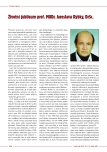Advances in metabolism and nutrition 2011 and the route to personalized treatment
Authors:
Z. Zadákihash3 1, 2 1, 2; M. Hronek 1; R. Hyšpler 2
Authors‘ workplace:
Centrum pro výzkum a vývoj Lékařské fakulty UK a FN Hradec Králové, vedoucí pracoviště prof. MUDr. Zdeněk Zadák, CSc.
1; Klinika gerontologická a metabolická Lékařské fakulty UK a FN Hradec Králové, přednosta prof. MUDr. Luboš Sobotka, CSc.
2
Published in:
Vnitř Lék 2011; 57(11): 970-974
Category:
Birthday
Overview
Current model of metabolic and nutritional disorders management utilizes modern techniques that promote some of the nutritional techniques to pharmacoteherapy. This approach is demonstrated on an example of multiple organ failure and systemic inflammatory reaction managed with pharmacologically active nutritional substrates, such as arginine, glutamine, taurine, threonine and cysteine. Treatment of sarcopenia in older age is also discussed. Personalized nourishment as a component part of a wider term personalized medicine represents a new approach that requires recognition of individual differences in human genome and its expression. However, this approach also requires a change of attitude towards laboratory diagnostics and clinical practice, with patients and clinical prediction as the focal point. From this perspective, there is a need to replace current traditional laboratory tests with a new system that utilizes molecular biology and bioinformatics.
Key words:
personalized medicine – nutritional pharmacology – nutrigenomics – multiple organ failure – sarcopenia
Sources
1. Aslami H, Juffermans NP. Induction of a hypometabolic state during critical illness – a new concept in the ICU? Neth J Med 2010; 68 : 190–198.
2. Li L, Hsu A, Moore PK. Actions and interactions of nitric oxide, carbon monoxide and hydrogen sulphide in the cardiovascular system and in inflammation – a tale of three gases! Pharmacol Therap 2009; 123 : 386–400.
3. Wagner F, Asfar P, Calzia E et al. Bench-to-bedside review: Hydrogen sulfide – the third gaseous transmitter: applications for critical care. Crit Care 2009; 13 : 213.
4. Mizock BA. The Multiple Organ Dysfunction Syndrome. Dis Mon 2009; 55 : 476–526.
5. Diamond IR, Pencharz PB, Wales PW. Omega-3 lipids for intestinal failure associated liver disease. Semin Pediatr Surg 2009; 18 : 239–245.
6. Vukovich MD, Stubbs NB, Bohlken RM. Body Composition in 70-Year-Old Adults Responds to Dietary β-Hydroxy-β-Methylbutyrate Similarly to That of Young Adults. J Nutr 2001; 131 : 2049–2052.
7. Guidi GC, Lippi G. Will „personalized medicine“ need personalized laboratory approach? Clin Chim Acta 2009; 400 : 25–29.
8. Zadák Z. Výživa v intenzivní péči. 2. vyd. Praha: Grada 2008.
Labels
Diabetology Endocrinology Internal medicineArticle was published in
Internal Medicine

2011 Issue 11
Most read in this issue
- Antibiotic treatment of acute bacterial infections
- Modern technologies in diabetology. CSII (Continuous Subcutaneous Insulin Infusion) and CGM (Continuous Glucose Monitoring) in clinical practice
- Management of obesity – options, effectiveness and perspectives
- Genetics of monogenic forms of diabetes
